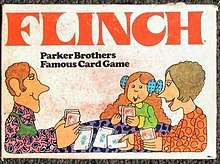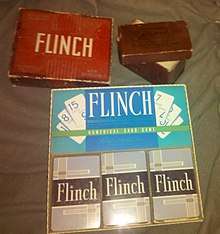Flinch (card game)
Flinch is a card game that was invented in 1901 by A.J. Patterson. Flinch is a card game that is based on stockpiling. The game is played with a custom deck and was first produced by the Flinch Card Company in Kalamazoo. This custom deck has 150 cards: ten sets of cards numbered from one to fifteen. Some variations use a deck that has 144 cards. Flinch is based on another game called "Spite and Malice".

_(109791848).jpg)

Invention
Patterson grew up on a farm in Eaton County, Michigan, and graduated high school at the age of sixteen. He moved from job to job in Grand Rapids and Chicago before he finally settled in Kalamazoo, Michigan as a bookkeeper at a stationery store, Beecher & Kymer.[1]
At home one day while he was playing cards, he came up with the idea for Flinch. He decided to create the game and the deck. Later, he ran the Flinch Card Company out of the stationery store, that was renamed Beecher, Kymer, & Patterson.[1]
Rules of play[2]
This game can be played with any number of players. Two to eight is the suggested number of players. More than eight can be accommodated by combining two decks of Flinch cards. The dealer deals each player 10 cards face down, which is their Flinch pile. The object of the game is to empty your Flinch pile. Next the dealer deals each player a hand of 5 cards. The rest of the cards, called the stack, are dealt out in groups of 5, when a player's hand becomes empty during play. Besides the stack and the Flinch piles, other temporary piles will occur during play:
- Piles in the middle of the table are accessible to all to be played on, in sequences from 1 to 15.
- As each player ends his turn, he places a card from his hand upright on top of one of his 5 reserve piles. When there are less than 5 piles, he must start a new one. He may only view the 5 top cards at any time.
To start the game, the first player turns over the top card of his Flinch pile and if it is a "1", it gets placed in the middle of the table, and another top card is turned over. The second player then turns over his top card, and repeats the process. This continues until all of the players have turned over their top cards.
In subsequent play, the current turn-holder plays his top card, whenever possible, on one of the middle piles. "2" cards are placed on "1" cards, 3s on 2s, and so forth until a pile reaches 15 and is removed.
- If the turn-holder's Flinch pile card can be played, but he fails to do so, other players may yell Flinch! The first to do so gets the credit. In the event of a tie, the player closest to the turn-holder's left gets the credit. Then the turn-holder must draw a card, unseen, from that player's Flinch pile, and place it on the bottom of his own Flinch pile, and his turn ends without adding to a reserve pile.
- If the top card cannot be played, the turn-holder is required to play a "1" from his hand, if he has one, starting a new middle pile. Otherwise he may play on an existing middle pile, either from his hand or from a reserve pile, if possible. His turn continues until he finally plays from his hand onto a reserve pile. Whenever his hand is empty, he receives 5 more cards from the stack.
See also
References
- "Flinch Card Company". Kalamazoo Public Library.
- "Flinch Rules". TheHouseOfCards.com. Retrieved 2019-07-16.